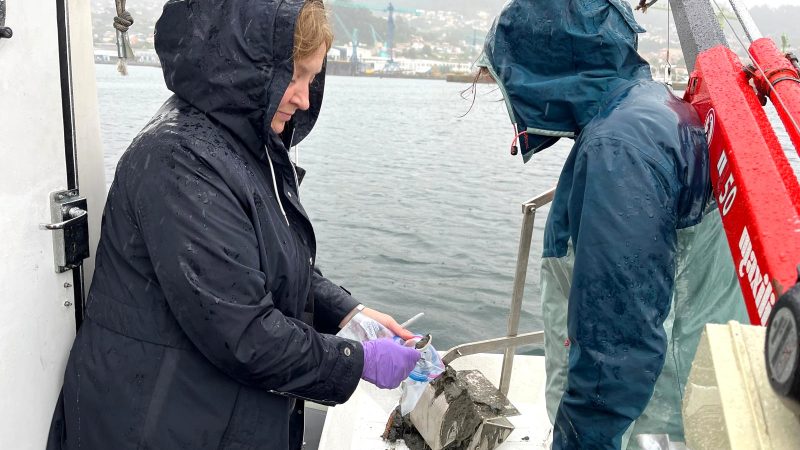Aboard the R/V Inndaga from the Geoma Group
With the aim of studying the diversity of microalgal communities in the water column (phytoplankton) and in the sediments (phytobenthos), an interdisciplinary group of researchers and students from various nationalities participated in a sampling in the Vigo estuary aboard the R/V Inndaga vessel from the Geoma rearch group. The activity, led by researcher Iria García Moreiras from the Marine Research Centre of UVigo (CIM), took place under the framework of the recently held international workshop on dinoflagellate cysts in Vigo.
Nutrient availability is optimal for the development of microalgae, making blooms quite common. So much so that in the laboratory, under an optical microscope, a bloom of the dinoflagellate Noctiluca scintillans was identified in one of the water samples collected in the Teis inlet. This microalga has pigments (carotenoids) within its cells that, at high concentrations, tint the waters a reddish-orange hue. Other microalgae capable of producing toxins were also detected, such as dinoflagellates from the genera Dinophysis sp. and Alexandrium sp., and also the species Lingulodinium polyedra. Additionally, in the sediments, the presence of resistant structures or cysts of some of these species was confirmed. These cysts can germinate and form microalgae blooms that could be harmful to the ecosystem.
Understanding the Functioning and Dynamics of Marine Ecosystems
Studies on the diversity and ecology of microalgae are essential to understand the functioning and dynamics of marine ecosystems, as they form the base of the food chain. Moreover, some species can produce toxic blooms that can negatively impact other organisms, shellfish production, aquaculture, and human health. This study also aimed to identify possible resistant structures that some microalgae (dinoflagellates) might form in the water column and deposit in the sediments. These structures are called cysts and play a crucial role in the survival and dispersion of these microorganisms.
Seven scientists with specialities in different fields participated in the sampling, coming from the universities of Lisbon and Minnesota, and three French institutions: the French Institute for Ocean Science (Ifremer), the Université Bretagne Sud, and the Nantes Université, as well as Iria García Moreiras, who conducts part of her research on the distribution of microalgae in the Vigo estuary and their potential as environmental indicators.
The research activity of the CIM is co-financed by the Xunta de Galicia and the European Union, through the European Funds (FEDER).
Source: DUVI

